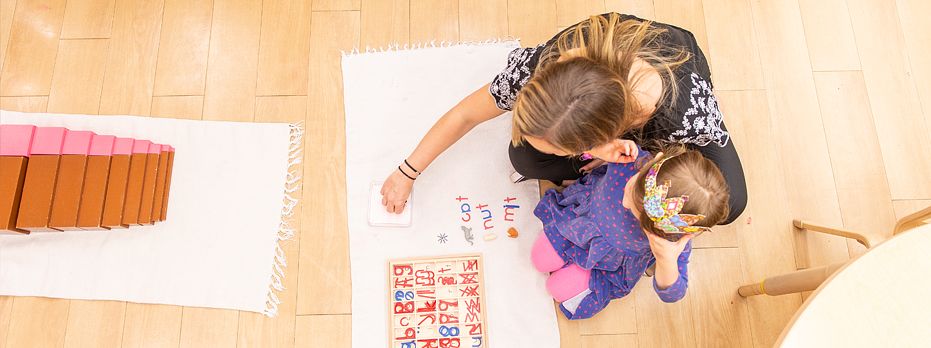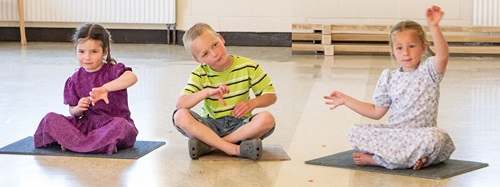Montessori: A Public Journey
| January 2009When people think of Montessori, seldom do they relate the name to public schools. Yet Dr. Maria Montessori developed the Montessori method itself in a public housing project in San Lorenzo, Rome over 100 years ago. Today there are at least 395 public Montessori schools across the United States (Jola, 2009).
The Montessori approach draws upon the natural development of the child. The method includes an emphasis on intrinsic motivation, the prepared environment as a key teaching element, a community of multiage learners leading to independence and responsibility, and progressive materials providing deep concentration and movement from the concrete to the abstract. Recently, much of Dr. Montessori’s keen observations of children leading to her philosophical and pragmatic approach are supported through modern scientific research shared in Angeline Stoll Lillard’s best selling book Montessori, The Science Behind the Genius (2005).
Dr. Montessori first introduced her methodology to the American public in 1913 during sold out lectures at Carnegie Hall and later returned to the San Francisco Panama Exposition of 1915 with her famous glass-walled classroom that drew thousands of spectators to observe children at work. For a variety of reasons, however, the educational philosophy did not translate to public schools in the United States until the 1960’s. Sand Elementary School in Cincinnati, Ohio, formally recognized as the first public school in the United States to fully embrace the Montessori method, did not open until 1975. Since then, cities such as Milwaukee, Denver, San Francisco, Hartford, Kansas City, Portland, Houston, Seattle, Dallas, Phoenix and New York City are among the many that have included Montessori Public Schools as a choice within their metropolitan districts.
Montessori organizations, including Association Montessori Internationale (AMI), American Montessori Society (AMS), and North American Montessori Teacher Association (NAMTA), value public Montessori schools as an integral part of their membership. The AMI-USA website states, “Often considered an education suitable only for a private school setting, increasingly the Montessori approach is being adopted by public schools with remarkable results. Though startling to some, families and educators familiar with AMI Montessori are not surprised at the benefits public school children have derived from a Montessori education” (2009).
In November 2008, participants from 15 school districts gathered at the annual AMI-USA Public School Forum in Kansas City, Missouri. There they shared their challenges and successes with implementing public Montessori programs. AMS recently created the “Montessori Public and Charter Networking Group” which provides public school staffs an opportunity for ongoing Internet dialogue on a multitude of topics. NAMTA early on, through its cooperation with the Public Montessori School Consortium, published Montessori in the Public Schools; Implementation Basics (1993) and has supported the growth and development of public Montessori programs. Most importantly, these three leading organizations, along with others, have agreed upon a document that defines quality Montessori in the public schools; aptly titled Essential Elements of Successful Montessori Schools in the Public School Sector.
Anyone can open a Montessori school, and there are no guaranteed regulations on how they may define themselves. Therefore, there is much variation in the quality of the implementation of the Montessori method in both private and public schools. The guidelines Essential Elements of Successful Montessori Schools in the Public School Sector draws on the writings, teachings and philosophy of Dr. Montessori. Key components are outlined in this critical document. Areas such as teacher training, multiage classrooms, extended student work cycles, and informed parents, are all defined with minimum expectations for the public Montessori school practitioner. This document provides the safe scaffold for any public school system wishing to begin a public Montessori program, or can serve for existing programs as the vehicle to develop school improvement plans based on sound Montessori principles. A complete copy of the Essential Elements can be downloaded at http://www.amiusa.org under “public schools”.
The Hartford Pathway: A Pioneering Experiment
The public Montessori schools in Hartford, Connecticut serve as a good example of how the Essential Elements have worked. As the first public Montessori school in the state, CREC Montessori Magnet School has demonstrated that it can meet these standards. Since 1999 when the regional education service center, Capitol Region Education Council (CREC), through the leadership of now Executive Director Dr. Bruce Douglas, assumed management of this struggling school, it has embraced the mission of creating a quality public Montessori school that would serve an ethnically, racially and economically diverse community. Located on the beautiful 16-acre city campus known as The Learning Corridor, CREC MMS is bordered by an impoverished neighborhood on the south end of Hartford.
Today the school boasts a student population of 340, ages 3 to 12. Fifty percent of the students come from Hartford and the other fifty percent of the student body are from 29 different school districts in the Greater Hartford Area. The CREC Montessori Magnet School was twice selected as a “School of Excellence” by Magnet Schools of America (MSA) for its success with student achievement, parent involvement, and racial and economic student integration. It was awarded the “Eugene M. Uram Award” by MSA as the most outstanding public Montessori school in the nation.
According to Denise Gallucci, Director of CREC Magnet Schools,
"Maria Montessori’s spirit is alive within the children, faculty, staff, and school community at the CREC Montessori Magnet School. The school community embraces the philosophy of educating the whole child, recognizing and celebrating each child’s unique talents and abilities. Public Montessori schools afford all interested families with access to this innovative approach to education. The Capitol Region Education Council is honored to offer this school as a learning laboratory for educators all over the world and as an educational opportunity to families within Greater Hartford Region”.
Drawing on the success of CREC Montessori Magnet School, and his previous experiences with Cincinnati Public Schools, visionary Superintendent of Hartford Public Schools, Dr. Stephen Adamowski has set forth to develop a continuum of public Montessori schools that will offer a Montessori education from two and half year olds to high school seniors. Dr. Adamowski shares his commitment to Montessori by stating, “Hartford Public Schools is reinventing itself as an all-choice system of high-achieving schools modeled after learning programs that have proved successful in other low-income areas. Our objective is to close the achievement gap between urban and suburban students, and prepare all of our students for a four-year college education. We would stand out by omission if we did not include the Montessori method in our menu of educational options. The program is recognized throughout the world as one of the most positive alternatives to traditional education.” Hartford Public Schools opened its own public elementary Montessori magnet school in August of 2008. The Montessori Magnet School at Annie Fisher in its inaugural year met a legally mandated racial quota outlined in the Sheff Comprehensive Management Plan (2008) through the difficult task of attracting both suburban families as well as various Hartford neighborhood families. It is the only Hartford-run magnet school in its first year to do so, and it was no surprise to Montessori education advocates that the theme had such a draw. The school’s design team used the Essential Elements as the basis for developing the school’s operation plan. Hartford Public Schools will open another program in 2010. A middle and high school program are to follow within 3-5 years. When this Montessori pathway is complete, a child can enter as a Montessori preschooler and graduate from a Montessori high school without ever paying tuition costs.
At the root of the Montessori Movement, Dr. Montessori believed that “one of the most urgent endeavors to be undertaken on behalf of society is the reconstruction of education. It must be brought about by giving….children the environment that is adapted to their nature” (1949). To achieve this goal more children must have access to a Montessori education. This can only be realized if Montessori schools serve the needs of all ethnic, racial and economic groups. With urban public school systems struggling with student achievement, racially isolated school settings, and economic crunches, a proven Montessori option for its children should be given close examination.
Resources:
Kahn, D. (1993). Montessori in the Public Schools: Implementation Basics. USA: MPSC.
Lillard, A. (2005). Montessori; The Science Behind the Genius. New York: Oxford University Press.
Montessori, M. (1949/1974). Childhood Education. Chicago: Henry Regnery.
Sheff Comprehensive Management Plan (2008). CT State Department of Education.>
Public school description (AMI-USA) Web site: http://www.amiusa.org (accessed February 26, 2009).
Public and charter school database (Jola) Web site: http://www.jola-montessori.com (accessed February 26, 2009).






